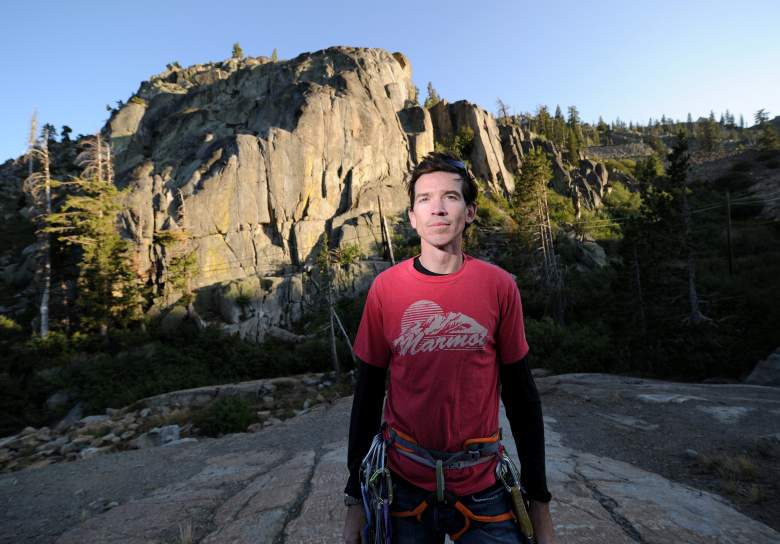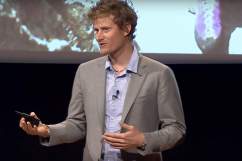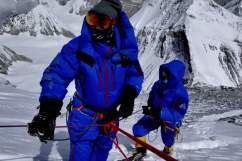
Adrian Ballinger at Lake Tahoe in August 2014. (Getty)
Adrian Ballinger is one-half of the “Everest No Filter” duo with Cory Richards. The two American climbers have made two attempts to reach Mount Everest without the help of supplemental oxygen and chronicled their attempts on Snapchat. They were also featured in the June 19 ESPN2 special SportsCenter Special: Everest No Filter.
The 41-year-old Ballinger, who was born in the U.K., is a world-famous climber who also does speaking engagements.In 2004, he founded Alpenglow, which arranges trips for wealthy clients who have thousands of dollars to spend on expeditions. Ballinger is dating fellow climber Emily Harrington.
You can follow Ballinger on Twitter and Instagram. His Snapchat usernames are adrianjb and everestnofilter.
Here’s what you need to know about Ballinger.
1. Ballinger Met His Girlfriend Emily Harrington at Mount Everest in 2012
It only seems right that Ballinger, an AMFA/IFMGA certified mountain guide and an Eddie Bauer guide, would meet his longtime girlfriend, Emily Harrington, on the top of Mount Everest. As Vogue notes, the couple met at Mount Everest in 2012.
In the interview with Vogue, Harrington said she bought a ticket to visit Ballinger in Tahoe the moment she came home from the Everest journey.
“We spent three weeks together before I flew back to Colorado, packed my Subaru, and drove out to California. I’ve been there ever since,” Harrington told Vogue. “Thinking back on it, it seems pretty out of character for me. I suppose I just had this weird confidence that we had something special and it was going to work out.”
Harrington is a five-time Sport Climbing National Champion who is partnered with The North Face and other brands. The 30-year-old Harrington is also on Instagram and Twitter.
Earlier this year, Harrington and Ballinger made headlines for climbing Cho Oyu, the sixth tallest mountain in the world, in just 14 days. The mountain stands over 18,400 feet tall.
2. Ballinger Survived an Avalanche During a 2014 Ski Trip in Alaska
Ballinger is also an expert heli-skier, which is off-trail skiing where skiers are taken to a remote summit by helicopter, not ski lift. As Sports Illustrated detailed in a 2016 story, Ballinger was on a trip with fellow heli-skiing guide Jerry Hance in March 2014 when he encountered an avalanche that nearly killed him.
Ballinger survived avalanches in Aspen in 2004 and the French Alps in 2006, but this one was particularly scary because he was far from the group he was with. Somehow, he survived the incident and was hospitalized after suffering a concussion. Ballinger was one of three members of the group hospitalized. One member of the group, Brad Gilbert, needed to stay in a hospital overnight.
Despite the accident, Ballinger didn’t think about not skiing for one second. He was back to guiding a group a week later. It was also six weeks before his planned sixth trip up Mount Everest.
“Managing and mitigating risk is what I do, it’s what I love. I’m not an adrenaline junkie in any way. If I’m getting adrenaline it’s because I’ve screwed up. Something went wrong, so I don’t like that,” Ballinger told Sports Illustrated.
3. Ballinger Has Climbed Mount Everest 7 Times
Ballinger’s 2017 climb up Mount Everest with Richards is the seventh time he’s reached the summit. In 2016, the friends tried to reach the summit together without the help of supplemental oxygen, but Ballinger had to turn back. In 2017, the roles were reversed, but Richards did make it to the top with the help of oxygen.
In a 2015 interview with Business Insider, Ballinger said that one of the keys of mountain climbing is not taking too many risks, but also committing to the ones you do take.
“When scaling a mountain peak, you’ll find it’s best to keep the risk taking to a minimum and take them only to avoid unexpected circumstances that might impact the ultimate success or safety of the climb,” Ballinger said. “These unexpected occurrences sapped my resources and left me emotionally drained. Sometimes I even began to question my original beliefs. But when I commit myself to the goal in the onset — I honor that commitment in the heat of battle. You should too, even when you’re facing a blast of wind and there seems to no end in sight.”
He also told Business Insider that it’s really important to rely on your team. It’s important to take advantage of teach others’ strengths to make up for any weaknesses you have. He also said it is important to be slow and steady, and not try to rush anywhere.
4. Ballinger Planned on Becoming a Doctor Before He Decided to Become an Adventurer
Ballinger was born in the U.K. and was a kid when he and his parents, along with his sister, moved to New England. Although his parents instilled a sense of adventure in him at a young age, he still planned on becoming a doctor. He told Men’s Journal that he was enrolled in medical school after he earned his undergraduate degree from Georgetown.
While at Georrgetown, he really got the climbing bug from Chris Warner, a mountaineer who taught a freshman outdoor leadership course there. He became Warner’s intern and Warner became his mentor. During his freshman year, Warner invited him to a trip in Ecuador and his parents got him a plane ticket for Christmas.
“My parents were super strict, but they always believed in going your own path. They had immigrated from the U.K. to America, and they always taught my sister and I to find what we love and pursue it,” Ballinger told Men’s Journal.
By then, Ballinger was hooked and he deferred his med school acceptance for a year. When he asked for a second deferment and Georgetown said no, he faced the ultimate decision. He decided against going back for med school. In 2004, he started guiding school.
5. Ballinger Worked With Uphill Athlete to Make Sure He Could Finally Reach Everest’s Summit Without Supplemental Oxygen
After he failed to make it to Everest’s summit without supplemental oxygen last year, Ballinger went to work to figure out how to help his body survive at such high altitudes without extra cans of O2. He worked with Uphill Athlete to find the answer to his puzzle.
In an interview with Men’s Journal, Bellinger said he was convinced that the hypothermia he suffered just hours from the summit were to blame on body fat and his gear, but Uphill Athlete had another idea. They thought it was because Ballinger was a “carb burner.” In a blog post on Ballinger’s training, Uphill co-founder Scott Johnson wrote:
At the time of Adrian’s climb in 2016, he was heavily reliant on eating some kind of high-energy bar, gel or similar product at once-an-hour intervals. What that immediately told me was that his metabolic preference was heavily shifted toward carbohydrate use. We often see this phenomenon with many long-distance athletes because they’ve been led to believe that if they aren’t fueling hourly during their workouts, something’s wrong.
They decided that Ballinger needed to completely change his training and dietary habits, despite his reputation as a skilled climber. But Ballinger listened to the advice and he succeeded.
“I feel like alpinists — and I’ll include myself here too — for the most part have approached climbing the same way forever,” Ballinger explained to Men’s Journal. “It’s just been, ‘How hard can you suffer? How hard can you beat your head against the wall?’ And whoever bangs their head against the wall the most wins, whoever is the most uncomfortable at base camp, or gets frostbite — like that is some badge of honor. It makes so much more sense to approach it scientifically.”



